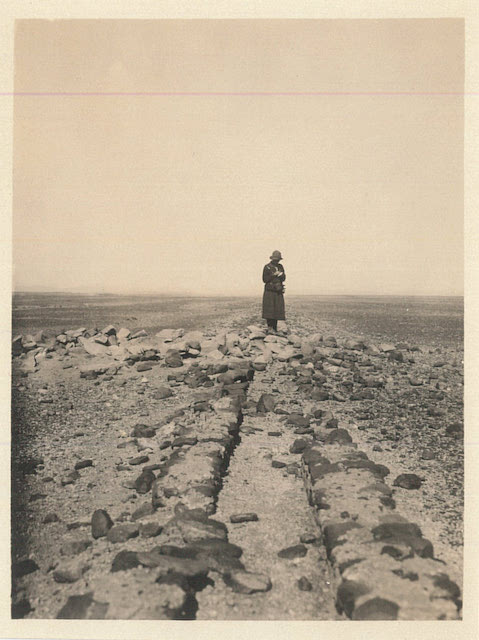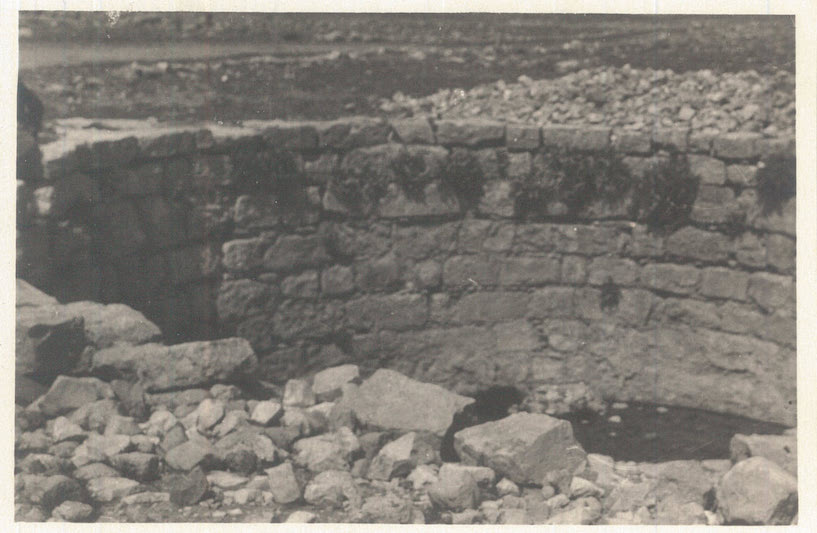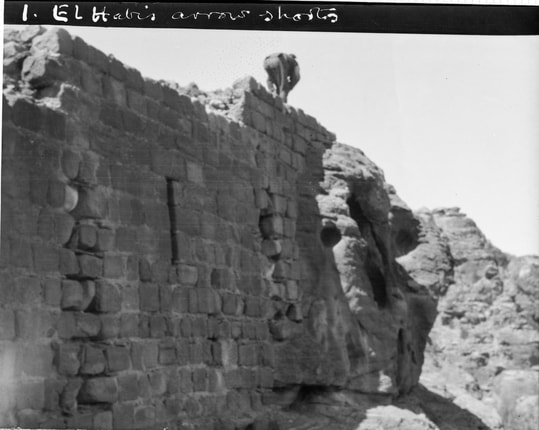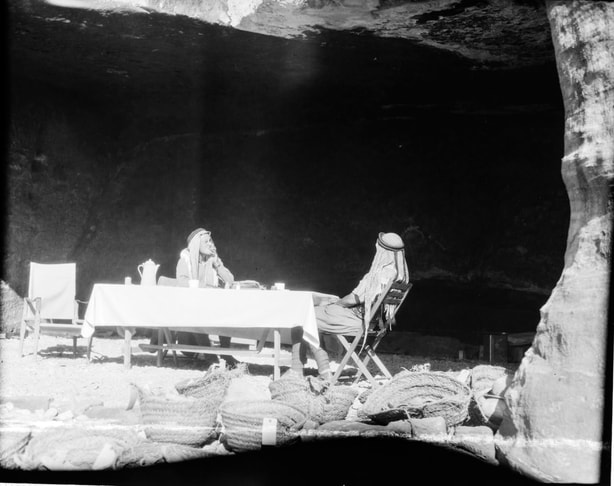|
[by Agnes Conway] After calling on the Governor of Ma’an [Khalaf Bey Atell] and Mr Strange, (Intelligence Officer to the Air Force) Mr Horsfield went to Ain Musa with one ton truck of luggage; met his 6 men who had ridden over from Jerash and sent them down to Petra to start preparing the Camp. He came back to Ma’an for the night.
Reference: Conway, A. 1929 (transcribed by A. Thornton). Petra Exploration Fund Diary. "Business Papers to be Kept", Horsfield Collection Box 8, UCL Institute of Archaeology, 21 March: 1.
[probably by Agnes Conway] Dr. Nielsen and A.E.C. left early, arriving at Petra for lunch, and had to put up at [Thomas] Cook’s Camp, our own not being ready. The Circassians from Jerash and local Arabs worked hard all day, under Mr. Horsfield’s direction, clearing out caves and building an oven. Mr Horsfield, Dr. Nielsen and A.E.C. climbed the mounds of the Roman city to see the points at which Mr H. had decided the dig should be begun. Dr. N. & A.E.C. photographed and examined the well at El Basta on the way down, which seems to be Roman and is very large and well-built. Reference: [unsigned, but probably Conway, A.] 1929 (transcribed by A. Thornton). Petra Exploration Fund Diary. "Business Papers to be Kept", Horsfield Collection Box 8, UCL Institute of Archaeology, 23 March: 3.
[probably by Agnes Conway] Dr. Nielsen and A.E.C. spent the morning on El Habis. He investigated Dalman’s 2nd sanctuary, and its precincts, finding what seems to be a larger cult centre than Dalman supposed, and possibly the earliest in Petra. To the N. and higher up is another altar court, which seems not to have been seen by Dalman 1 The chambers along the southern slope of the hill are partly houses and partly tombs, in some cases a tomb and a house being side by side. The tombs, in some cases a tomb and a house being side by side. The tombs have ornamented facades and the houses are plain. Close to the second sanctuary there are many tombs. In the afternoon he found a long artificially made terrace, also probably connected with the sanctuary and above it to the E. (this was later identified as a water catchment area). A.E.C., after some searching, found the way to the top of El Habis, the acropolis of Petra, on which are the walls of a castle, generally supposed to be a Crusading, and outlining the summit. In one portion are two complete arrow-shoots. She looked down from it onto the southern peak of El Habis, on which is Dalman’s 1st sanctuary, a huge rock-hewn altar.2 She spent the afternoon trying to find the way up to this peak, but without success. A piece of mediaeval Arab pottery (about the time of Saladin) was found on the southern side of El Habis. Mr Horsfield and all the men worked all day long preparing the Camp. Mr Horsfield explored the rock chambers above the Camp, some of which have crosses on the walls. The tooling on the walls of all the caves seemed to A.E.C. to be similar to the remains of tooling in the limestone caves of Beit Jabrin in Palestine.
The whole of El Habis is unplanned and should be done – only the 2 actual sanctuaries have been sketched by Dalman. -- [Footnote] 1. Later rejected as a sanctuary. [Footnote] 2. Later identified as a quarry Reference: [unsigned, but probably Conway, A.] 1929 (transcribed by A. Thornton). Petra Exploration Fund Diary. "Business Papers to be Kept", Horsfield Collection Box 8, UCL Institute of Archaeology, 24 March: 3-5. [probably by Agnes Conway]
Mr Horsfield spent the day completing Camp arrangements, and all the party moved in in the afternoon and slept there. In a morning of 5 ½ hours Dr Nielsen and A.E.C. visited the Tomb of the Urn, and felt certain that it had originally been a Temple (later decided it was a tomb); and was transformed into a church by making 3 apses out of the 6 Nabataean (tomb) recesses, as suggested by Irby and Mangles. They first tried to climb El Hubta by a staircase which led to El Ramleh, and noticed several places of cult by the way which do not seem to have been described by Dalman1. They then found a direct way up El Hubta and investigated the sanctuaries along the N.W. wall, described by Dalman, which form an elaborate cult centre. Byzantine pottery was found on the Watch Tower. A.E.C. climbed the most southerly lump and copied an inscription of 6 letters, looking like 1916. The language not identified 2. She was struck by the interesting views from that point, of El Ramleh from above with staircases and places of cult; of Zibb Atub with both obelisks and the castle clearly visible; and of Al Bijara, with what looked like artificial work on top, and decided to take telephoto photographs from that point if possible. A plane-table map of the top should be made, as it was left out by Brunnow, and Dalman merely deals with the individual sanctuaries. -- [Footnote] 1. These are quarry cutting remains [Footnote] 2. Nabataean Reference: [unsigned, but probably Conway, A.] 1929 (transcribed by A. Thornton). Petra Exploration Fund Diary. "Business Papers to be Kept", Horsfield Collection Box 8, UCL Institute of Archaeology, 25 March: 5-6. [by Agnes Conway and George Horsfield] Dr. Nielsen spent the day working at the Sanctuaries on El Habis, and felt that he had discovered enough in one morning to justify his journey. This complex of cult monuments, all orientated to the west, seem to him to be the earliest Arabian sanctuaries, circa the 2nd millennium B.C. He thinks that the bulls heads on the so-called “pulpit” and the cone shaped top, somewhat resembling a coil, of snakes, are of human workmanship, though much weathered. (He turned this down afterwards). A.E.C. spent the morning and afternoon exploring the Wady El Tughra. Below El Habis, S of the sanctuaries, she found what might almost be called a cemetery of shaft graves, some leading into large tomb chambers below. All were of solid construction and considerable depth, but the roofs in all cases had gone and the contents were rifled. One shaft grave had 3 small detached obelisks near it, and the holes for the bases stood at the head of the grave 1. The graves on the opposite side of the Wady under El Bijara are much later. Two sumptuous Nabataean temple graves have later partition walls of large stones, regularly built (prob. Bedouin?). One large tomb with a niche for a single grave has only a small hole knocked out of the slab and might be worth exploring for its contents. Following the Wady southwards a large irregular lump of sandstone in the middle (the Kegelberg) is also a collection of shaft graves, and further on on the western side are a few shaft graves in front of some of the largest Hellenistic tombs. The green plateau between the Wady and the W. face of El Biijara is a mass of large worked stones, probably Greco-Roman and looked to her like remains of the town. Where the Wady en Mer runs into the Wady el Tughra are a few rock-hewn caves, almost entirely silted up with sand, which might be worth excavation. G. H. started digging in mound S.W. Zubb Pharoon [sic], on the part that lies above Dalmans [sic] “Byzantine” Wall. It is covered with Byzantine pottery but the steps cut in the side of the mound produced very little. The mound in this part is composed of sand and a certain amount of burnt debris, probably from wood fires, but contained no charcoal. The sand is loose and the digging had to be done with caution for fear of a land slide. In the afternoon moved further South, where the debris is deep, and higher up the mound, which is apparently surmounted by a fortified wall which is not shown in Dalman’s plan. It breaks out from the Byzantine wall then turns until it meets the rock, with a shaft tomb. Below this lies another with slabs in place, one being broken so that you can peer in. It is partially filled with debris, and seems to have a chamber on either side. The pottery finds were poor, but a deep cutting may be interesting. The evidence so far obtained points to the wall being pre-Byzantine, as it is buried in debris of this period. Today the Camp was finished. It is situated in the Wadi Deir, in caves on both sides. In the West is the cookhouse, Living Room, W.C. and stables, and beyond a Bathroom. Dr Nielsen and Miss Conway are accommodated in tents. On the East is the Guardroom, which is also used as a Store House; adjoining is a small cave for G.H. and next door is the Guest Room. It is fairly compact, and the guard room covers all points of approach.
Many deficiencies have been discovered in the equipment, which was reduced as much as possible. These are being taken in hand, and Thos. Cook and Son’s camp, in the person of the Manager, has been most helpful. It is impossible to buy anything at Elgi, except the poorest things. No vegetables are obtainable. Milk is procurable. Chickens and sheep have to be got from the Arabs some miles away. Arrangements are beginning to work, so that all the attention of the Expedition may be given to the work of exploration. __ [Footnote]: 1. These are probably not holes for obelisks, but the ordinary ones for offerings. Mr Horsfield excavated these shaft graves later on. Reference: [unsigned, but by Agnes Conway and George Horsfield] 1929 (transcribed by A. Thornton). Petra Exploration Fund Diary. "Business Papers to be Kept", Horsfield Collection Box 8, UCL Institute of Archaeology, 26 March: 6-9. [By Agnes Conway]
A. C. The day, being a Friday, was a holiday from the dig. Dr Canaan began his work on local place names, which he is deriving from the local Bedouins, especially the Bdûl, and took one with him to the Deir. He also began a collection of local flora to get the local names. Dr Nielsen and A.E.C. went up the Wady Turkamaniya to a hill at Idhra’ al Hisha which commands a superb view of the whole city area of Petra and the great mountain circle. The circle at the top of the hill is outlined with enormous stones and was thought by them to be the northern fort of Petra (First discovery of Megalithic circle). They visited the Turkamaniya Tomb and the sanctuary visited yesterday, which turns out to be Dalman’s Ma’aisera Sanctuary No 4. They compared Dalman’s plan on the spot, and considered some of it a romance. Mr Horsfield and A.E.C. went in the afternoon over part of the same ground and decided to dig out the 2 sarcophagi in the vault of the Turkamaniya tomb. Mr Horsfield noticed 2 stone coffins at the bottom of the Turkamaniya Wady, opposite the Tomb, under 10 ft of deposit, which may be very early and unrifled. (Xtian) The stone circle at the top of the hill, unhewn and very small for a fort, he thought might turn out to be the enclosure wall of a very early sanctuary, as a worn away rock inside might conceivably be an early alter and is on the most dominating site in Petra. A.E.C. decided to take telephoto plates of the views in every direction to make a panorama of the Petra basin. They walked down to the Wady Mataba where a wall of large stones built on no foundations canalized the Wady – they followed up lengths of wall as far as the Nymphaeum, all of which represent important problems as the fortification of Petra. Dr Nielsen continued his work on the Sanctuaries on El Habis. Reference: Conway, A. 1929 (transcribed by A. Thornton). Petra Exploration Fund Diary. "Business Papers to be Kept", Horsfield Collection Box 8, UCL Institute of Archaeology, 29 March: 14-15. [probably by Agnes Conway and] by George Horsfield
A.E.C. took Mr Horsfield to see 3 silted up caves above the Wady Farasa, which may be worth digging at to see if they are early. He also investigated Dr Nielsen’s El Habis sanctuaries and climbed a mountain at the back of Wady Ed Deir and our Camp, to copy a new Nabataean inscription found by his Circassian Inspector, Ali, at the very top. Dr. Canaan covered a large area identifying place-names. A.E.C. and Dr. Nielsen went up the Ma’aisera again. She worked through Dalman’s Sanctuary No. III, which seems the most complete and interesting of them all, and was delighted with the long terrace on the edge of the Ma’aisera El Garbiyah which looks like the esplanade of a great Italian city. March 30. G. Horsfield No digging was done as the workmen failed to turn up. Saw the Sheikh Bashir and it seems to be his doing, as he wants to collect his share of the plunder. I informed him that I was indifferent whether they came or not. Explored the mountain on the W side of Wadi Deir over the Camp with Ali, and copied in part the Nabataean inscription which Ali found the other day. My transcription was poor and the inscription deteriorated, so Dr Nielsen was not able to make it out. The excavators from Doura (on the Euphrates), Mr and Mrs Hopkins and Mr Johnstone, arrived about 7.30 p.m. in search of a cave for the night with a letter from Alright [sic] of the American School. Gave them a table and a corner of the living area – which is a nuisance for the rest of the party, though they in no way interfere with us except by their presence. We have decided to clear out another cave on the other side, which will do to put up chance visitors who will have the benefit of the guards and complete independence. Reference: [probably Conway, A. and] Horsfield, G. 1929. Petra Exploration Fund Diary. "Business Papers to be Kept", Horsfield Collection Box 8, UCL Institute of Archaeology, 30 March: 15-16. [By George Horsfield and Agnes Conway]
G. Horsfield Went to Ma’an with Arif hassar for money in company with Mahmud Charish. Brought back £200 which I obtained after waiting 3 hours. The digging went on with 25 men without interruption and supervised by Ali Burar. A.E.C. and Dr. Nielsen went to Al Najr to find Kennedy’s High Place. Approaching it from the back side they could see nothing towards the top that looked worked; but as Difollah shouted down that it was good, AEC was hauled up. The top, which is about 57 yds in length, at first seemed to her a quarry mass only – but gradually it appeared to unfold itself as an altar mass with a gap left in the back wall orientated to the W. At one end is a small niche with a horned altar; at the other a larger niche. It divides itself roughly into 3 terraces, on the middle of which are 4 blocks, beneath what might be a tier of seats on the N edge. On the lower terrace close to the E. precipice, is what might be an altar. A very little pottery of uncertain date is strewn about. Seen from the ground in the E. side is a small projecting platform, upon which there appears to be a similar altar, which must again be investigated from the top. Should it be a High Place a fine view could be had of the sacrifices from the wide open space below which leads up gradually to a tomb area. Dr. Nielsen was unable to climb to the top. A.E.C. thinks the massif may originally have been a High Place, which was afterwards quarried away to build the city, any staircase approaches being then cut off. Marks of quarry working seem to be clearly visible in the projecting portion on the S., and there are small carvings high up which might be mason’s marks. In the afternoon A.E.C. walked on the Ma’aisera ridge above the Camp, spotting from above a large built wall inside a cave or tomb, and then going to Kennedy’s fig. 149 to look up the suggestions in his Memorandum. Dr. Canaan did two big rounds finding place names and collected stories as usual from the Bedu. Reference: Horsfield, G. [and Conway, A.] 1929 (transcribed by A. Thornton). Petra Exploration Fund Diary. "Business Papers to be Kept", Horsfield Collection Box 8, UCL Institute of Archaeology, 1 April: 18-20. [By Agnes Conway and George Horsfield]
A.E.C. took Mr. Horsfield to see Al Najr, and he pronounced the whole place to be a quarry, probably temp [sic] Hadrian to build the Hadrianic city. The horned altar and niche would just have been put up by the quarrymen to amuse themselves. All the surrounding cult places, recommended by Kennedy for examination, are quarries as well, and to have fixed this definitely will save us all a great deal of time. We walked through Al Nasara, also full of old quarries which looked like cult objects, to the suburb on the N.W. face. Here Mr. Horsfield agreed that the tricliniums, niches, rooms etc all included by Dalman in his account of the 6 sanctuaries under El Hubta, are houses. One room is particularly fine and considered by him to be the earliest specimen of a typical Arab house. G. Horsfield Spent the morning with Miss Conway visiting Northern area, in which I dashed all her hopes, as the alleged Higher Places are all quarries and the crude symbols the products of the leisure of quarrymen, visited some of the rock cut chambers on the S side, many of which seem to have been houses. The facade without a door, in front of which is a wall, seems to have been a Nymphaeum. Spent the afternoon on the dig – a wall has appeared on the W. side which seems early. Pottery same as before and scarce but the house debris, bones, pottery and ashes are in evidence. The work is going better and with more of a swing, as the men are broken to organized labour – 26 men employed – taking on 10 more tomorrow. In the afternoon A.E.C. investigated the caves around El Habis which all seem to be houses of different dates. One has remains of a very fine black plastering on the walls and ceiling. Reference: [By Conway, A.] and Horsfield, G. 1929 (transcribed by A. Thornton). Petra Exploration Fund Diary. "Business Papers to be Kept", Horsfield Collection Box 8, UCL Institute of Archaeology, 2 April: 20-21. [by George Horsfield and possibly Agnes Conway)
G.H. Worked on 3rd level and finished clearing of second. From this came three fragments of figurines etc., camel’s head and horse’s body with trappings and the upper part of a female figure. Cleared up the washing water supply in the morning and finished clearing of high place, el Habis, and cleaned out the tomb chamber on lower level – found nothing. The whole area has been quarried at the high place and part of the basin fronting “altar” cut away. The proper name of rubbish heap “el Aziz” is “katoote” meaning “that which slides down” from “Kalta” to slide. Some of the other things bought at Amman arrived. Examined the West side of El Habis for fortifications. A.E.C. took notes of the caves and foundations of the buildings, some of them built with large unhewn stones, leading up to the Megalithic circle from the South, on the chance that they may prove to be in some way connected. She finished planning the rock inside the circle. Explored the caves and houses at the opening of the Siyagh on the N side, finding that to be a house area with remains of good plaster work and stucco and two pieces of worked white limestone. One of the houses seems to be built in three stories; but the red sandstone has lost its surface to such an extent that it is no good studying houses in that area. Reference: Horsfield, G. [and Conway, A.] 1929 (transcribed by A. Thornton). Petra Exploration Fund Diary. "Business Papers to be Kept", Horsfield Collection Box 8, UCL Institute of Archaeology, 4 April: 22-23. |
Categories
All
Archives |




 RSS Feed
RSS Feed